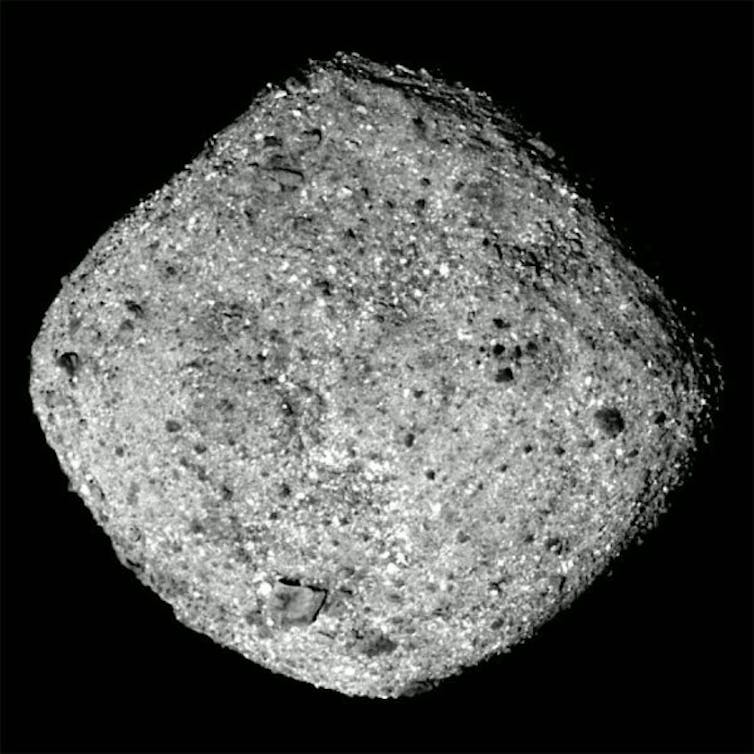Asteroid Bennu, trapped in crust of ocean world

An examination of a small portion of the 121 grams of samples returned from the asteroid Bennu by NASA’s OSIRIS-REx mission has yielded a discovery that is as surprising as it is unexpected. Many of the fragments pulled from the asteroid’s shell contain minerals that point to a watery past on the world from which it originated.
In particular, a research paper now being published, led by mission principal investigator Dante S. Lauret and Harold Connolly, demonstrates the presence of phosphates and other minerals of widespread hydrous alteration in the excavated rocks.
Well hydrated planetary embryos
The early days of the solar system were marked by the growth of so-called planetesimals from materials that condensed around the Sun about 4.565 million years ago.
The collision of these first blocks resulted in the formation of hundreds of planetary embryos, some of which were hydrated and gave rise to water-rich planetary bodies.
However, the vast majority of these planetary embryos were destroyed in the colossal collisions that resulted in the four rocky planets in our solar system. Perhaps some were lucky enough to be located in corners less susceptible to violent impacts, as may have been the case with the largest asteroid in the solar system, Ceres. In fact, this large asteroid contains more water than our own planet and is a future astrobiological target.
The Bennu samples contain sodium magnesium phosphate, which came as a surprise to the research team because it had not been identified from the remote sensing data collected by OSIRIS-REx. These types of minerals are found in Earth’s oceanic crust and are characteristic of ocean worlds. So its presence in the rocks brought back from Bennu suggests that the small asteroid may have broken away from a long-vanished primitive ocean world.

In fact, a recent study of the orbital dynamics of Bennu, as well as the asteroid Ryugu, suggests that both asteroids, samples of which were returned by the OSIRIS-REx and Hayabusa 2 missions, respectively, must come from a large family associated with the asteroid 142 Polana, which is about 55 km in diameter.
These clusters of multiple objects, likely the result of catastrophic fragmentation of a larger parent body, are commonly found in certain regions of the main asteroid belt between Mars and Jupiter. Asteroid families are nothing more than tangible evidence that larger bodies have been destroyed by colossal impacts over millennia.
These asteroid remnants, very dark bodies that reflect less than 5% of the light they receive from the Sun, produce meteorites known as carbonaceous chondrites, some of which are hydrated. So early detection poses a challenge for asteroid-hunting programs.
In fact, let’s not forget that Bennu is one of the asteroids being studied by NASA’s SENTRY program for its future close encounters with Earth later in the next century, although its dynamic evolution poses no short-term risk.
The relevance of sample return missions
There is no doubt that the material recovered by OSIRIS-REx is key to unraveling the first hydration processes of the first worlds to form in the solar system. But it may also provide clues about the catalytic properties of organic compounds that the primordial minerals that make up these rocks may have contributed to the emergence of life on Earth.

But also, the analyses of rocks recovered from the surface of the asteroid Bennu remind us of the urgency of developing this type of sample return missions, rather than waiting for them to reach our planet on their own. Especially since some of the minerals they contain may not survive the millions of years the rock would have to travel in space until it reached our planet, as well as the ablation and slowing down that the rock would undergo in the Earth’s atmosphere, which would cause it to lose much of its original mass.![]()
Josep M. Trigo Rodrigues, Principal Investigator of the Meteorites, Small Bodies and Planetary Sciences Group, Institute of Space Sciences (ICE – CSIC)
This article was originally published on The Conversation. Read the original.